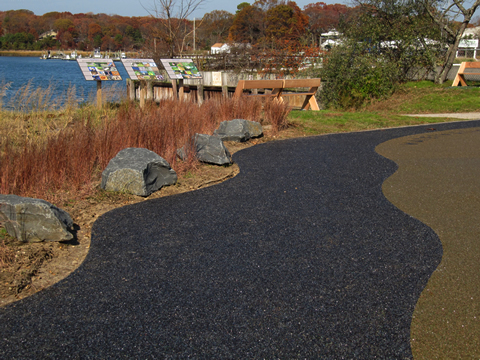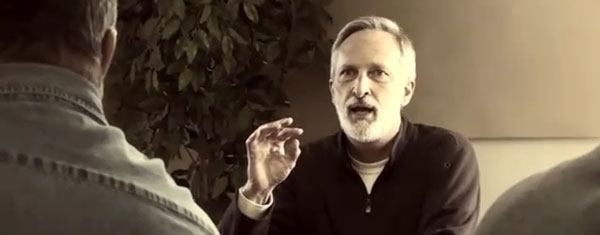
New Video – Harvest 2010
Check out this great video filmed and edited by our own Natalie Saragusa – a chronicling of Harvest 2010 and the community surrounding it.
Throwing Myself to the Renewable Energy Wolves
I received the opportunity on Monday to sit in on a meeting at TS Designs. Little did I know, I would be jumping out of a proverbial plane into a foreign country where I knew not a word of the national language - Renewable Energy Land. If you have had the pleasure of...
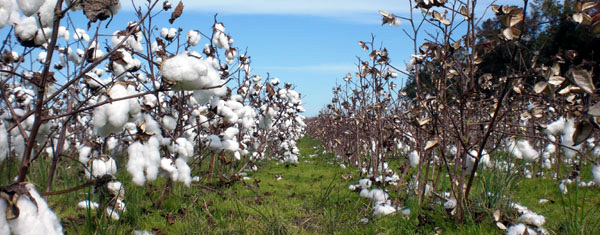
The Cotton Crazies
Commodity prices are on the rise, and cotton costs more than it has in decades. Read on to learn how this will affect you.
These guys are good, mate.
If you've been wondering what happened to your TS Designs Blogger for the past month, thank you. I didn't even think you'd have noticed. For those of you who didn't miss me, I won't hold it against you. Honestly, you guys haven't been on my mind a WHOLE lot either....
An Open Letter from President Eric Henry
As I reviewed our personal financial portfolio at the end of 2010, I noticed we got a nice bump to our net worth, gains from the stock market. On the other hand, it was another tough year for our small sustainable printed apparel company in North Carolina. A company...
When warm and fuzzy feelings don’t cut it…
Visiting artist – activist, Lillian Ball graced Elon with her presence two weeks ago. Her work has spanned a few decades, stemming from a formal college education in anthropology, transforming into an active role in gallery sculpture & video installation on an international level. One day, Lillian realized that ART WAS NOT ENOUGH. She had so much more to offer the real world. With her back turned on the institution of the gallery, she now faces a world with broader opportunities: the real world, which she distinctively separates from the art world.
Ball’s work that most interest me is her Bronx, NY-based Waterwash. Now, while I, as an artist first labeled this as an installation, it’s really more like an investment. What she has done is taken recycled glass, crushed it, and melted it into a platform of sorts near the bank or shore of a body of water. When storm water flows towards the adjacent stream or lake, the water doesn’t pool, it disperses, is filtered, and runs off towards the water source, cleaner and healthier. Past this stage of the process, the water must pass through a wall of filtering plants that further remove toxins from the storm water. The issue with the way we’ve produced surfaces in the past, Ball says, is permeability. Plants and natural organisms can break down poisons we inject into our environment. However, if we don’t allow the toxins to GET to these decomposing machines via slower run-off, they can’t do their job.
Companies that produce toxic run-off are looking at Ball’s technology now to protect their surrounding water sources and communities. This is really important to keep people, animals, and habitats clean and healthy. TS Designs stresses that this is one of the most important parts of their business, too – keeping the community safe, happy, and healthy first. By implementing these eco-friendly developments, you do not solely aid yourself – you are positively affecting every life directly and indirectly touched by your livelihood. The same applies in the other direction, negatively. Take a moment to assess your stakeholders: your clients, your distributors, your neighbors, and your backyard wildlife. How are you impacting them? How are they impacting you?
New! Customize Your Own Ladies Breast Cancer Awareness T-Shirt
Want a unique TS Designs t-shirt but don't want to order in bulk? We're now offering a program that will allow you to individually customize a stock design and order a single shirt on our website! Our first design is just for the ladies: a white or pink AnvilOrganic...
NC Farm Bureau Article
The North Carolina Farm Bureau Magazine's November issue featured a great article about TS Designs and our Cotton of the Carolinas harvest tour. Check it out here!
Picking Cotton & Building Community

Saturday marked TS Design’s Second Annual Fall Harvest in partnership with farmer, Ronnie Burleson and the Rolling Hills Gin located in New London, North Carolina. The gorgeous weather and beautiful company made the group’s time spent together remarkable. However, the most notable part of the day was the message clearly sent by all in attendance: our consensus on the importance of Community.
The day began at Rolling Hills Gin, where Wes (who we learned wears many hats: manager, electrician, mechanic, and tour guide…just to name a few) gave us a run down of how the gin works. Fascinating. We explored the premises, little green plugs in our ears, bringing the roar of the gin down to a pleasant murmur. The inner workings of the mechanical side of cotton processing is quite magical. A light flurry of cotton snowed down over our heads as we spread out among the machinery, all of us with our mouths slightly agog.
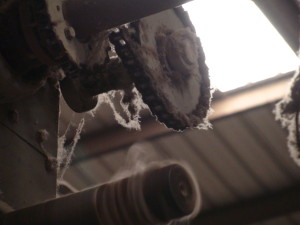
After a delightful luncheon at a nearby church, we took some much needed time to get to know each other better. One by one, our group introduced themselves and told their story of sustainability that inevitably led them to join TS Designs on our adventure. From business owners to architects, and municipal planners to college students, our ranks were diverse. However, as one of us put it so eloquently, “Really, it all comes down to community.” It was just a frank and purely beautiful statement. Because, truly, when you think about it, that’s where we all gather our strength. If not for community, that business owner would have no clientele. If not for community, that architect would have little purpose behind their creation. If not for community, that municipal planner would just downright be out of a job. And for this college student, me – if not for community – it is probable that I would have never stumbled across the TS Designs family on my college campus, one of the best things that has happened to me in a long time. Not only me, but everyone in attendance was feeling the TS spirit on that lovely, crisp October afternoon. Not only does this company do the right thing by Mother Nature, but they bring it to the people as well.
Moving out to the fields of New London, it was apparent that the bonds made by our President, Eric Henry, are the kinds that most businesses always seek but may never secure. Rows upon rows of cotton, just waiting to be turned up by Ronnie’s new fancy shmancy John Deere cotton picker waited before us, and a strange exhilaration of anticipation revved everyone up – yes it was a weird and novel concept, getting psyched about farming, but it was exciting. Yet, there were Eric and Ronnie, chatting away. We all were running like six year old boys at a $600,000 cotton harvester, lining up for 3 minute rides as if it were a roller coaster. But all the while, TS Designs and one of its farming partners were just talking shop.
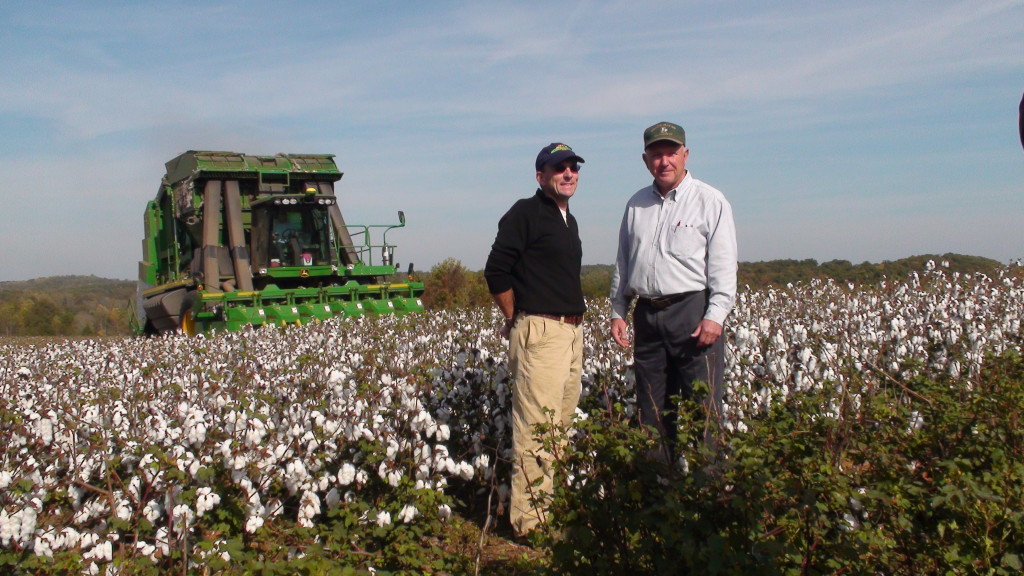
Community comes first. A strong community is the foundation. Everything else can fall into place after that.
Think about it: what are YOU doing to build community in your home, neighborhood, business, and world?
PEACE LOVE & T-SHIRTS,
Natalie
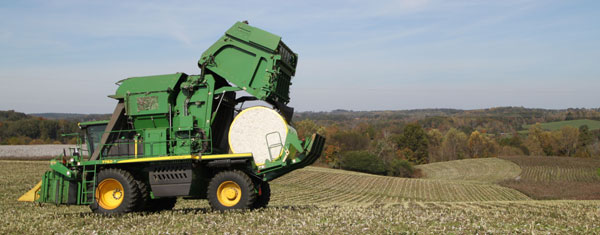
Harvest 2010 Tour a Success!
Check out some great photos of Harvest 2010 – our celebration of Cotton of the Carolina’s cotton farmer.
Harvest 2010
It’s that time again! Cotton-pickin’ season is right around the corner, which means we’re inviting all our friends out to our Harvest 2010 tour! Join us in New London, NC to celebrate Ronnie Burleson, our own Cotton of the Carolinas farmer. Details below!
 Harvest 2010 Agenda
Harvest 2010 Agenda
Saturday, October 30th, 2010
10am – meet at Rolling Hills Cotton Gin:
29107 Kendalls Church Road, New London, NC
10-10:30 – introduction of the CotC team
10:30-11:30 – tour of cotton gin
11:30 – out to the farm
12-1 – lunch at the farm
1-2 – visit the field / ride the tractor
2-3 – Q&A, wrap-up and head home
Details
Price – $10/person – includes local lunch
Group Transportation / RSVP – Contact Eric Henry
*RSVP by 10/23*
TSD Now Offers Less Expensive Sustainable Options!
 TSD is partnering with Anvil Knitwear to offer less expensive t-shirt options that exhibit a wider range of sustainable qualities and prices
TSD is partnering with Anvil Knitwear to offer less expensive t-shirt options that exhibit a wider range of sustainable qualities and prices
To learn more about both our Anvil offerings and our TSD brands, check out our shirt styles page.
We want to support our customers with the right product no matter where they are on the continuum of sustainability. Anvil’s lines of conventional cotton and certified organic cotton t-shirts will help to supplement our own TSD brands for customers who want to start pushing their apparel in a more sustainable direction.
And though most of Anvil’s t-shirts are manufactured in Honduras, we partnered with Anvil specifically because of their comprehensive Corporate Social Responsibility Report.
The Buzz
Monday night was quite a trip, both literally and figuratively. Literally speaking, my driving adventure to the Charlie Rose Agricultural Center in Fayetteville was peppered with three fender benders and more neon-bedecked “cabarets” than you can shake a stick at. In the figurative sense, this was my first night of beginner beekeeping class. You can bet this twenty two year old in pink Converse high tops got some puzzled looks from the 40, 40 year old plus farmers donning work boots and overalls. A man by the door just came right out and said, “You lost, sugar?”
No, sir. I am very much in the correct place. But thank you anyway.
So you’re probably wondering why the heck I’m taking a beekeeping class, too. I won’t take it personally. My roommates have been relentlessly teasing me about picking up bizarre hobbies like dragon training and snail racing this week. But you’d be surprised; this new interest of mine isn’t as random as it may sound to the untrained ear. Lately at TS Designs, we’ve been talking a lot about the power of these little pollenating machines: our bees.
Bees are amazing creatures. That much, I learned in the first ten minutes of my absolutely fascinating beekeeping class. Their hives and colonies are smooth operating apparatuses. The life purposes and hierarchies of the queens, the drones, the worker bees, and the larvae are intricately executed and perfectly balanced.
TS Designs keeps a hive for a couple of reasons:
1. To harness the power of pollenation: natural miracle grow.
2. To harvest honey in order to sweeten in a more sustainable way.
Bees are the ultimate gardeners. By increasing our number of local pollinators, we increase the health and growth of our glorious flowers, the produce in the Garden of Eat’n, and the surrounding trees. Pollination not only promotes growth of individual plants, but also the spread of foliage. Our bees can travel as far as 5-7 miles outside of the constraints of the TS Designs property line – maybe they’re pollinating your yard too. You never know.
By producing our own honey, we take one more step towards attaining the very best sustainable practices we can. In the beginning, TS Designs used your standard packets of sugar to sweeten our morning coffees and teas, just like everybody else. But we’re not like everybody else, so we made the switch to large plastic containers of organic sugar for everyone to share. Realizing that there was an even BETTER solution to this issue, we invested in some outside help – the bees. Now, with our hive pumping out our very own honey, we’ve forgone sugar for this far more sustainable and equally (if not more) delicious alternative.
So Monday night blew my mind. At some point in time, I’m going to scan in my notes I take during class to show you all. I’ve got diagrams flow-charting to illustrations with formulas regarding bullet points next to pictures of cute little bees I have drawn. It’s nuts, I tell you. Nuts. I’ve made a goal for myself to become a certified Master Beekeeper by the end of my senior year of college. For the next five weeks of my class, I’m so looking forward to sharing my latest endeavor with you!
Bee cool.
Peace, love & t-shirts,
Natalie
A Green Revolution
This semester, I’m taking an Environmental Development class focused on the development of Asia, South America, and Africa. I recently gave a presentation on the Green Revolution of India. The Green Revolution was a movement enacted from 1967 to 1978. Delayed as it may have been, it came about in response to the Bengal Famine of 1943.
Under the colonization of the British, Indians’ food supply was pushed to the backburner behind World War II hysteria. Over 4 million people starved to death. After the immediate effects of the famine subsided, farmers attempted to overhaul their land. Futile attempts at revamping the existing farming lands continually failed. Finally, nearly 25 years later, the government took action.
Three major steps were taken to start the ball rolling in the right direction for India: new farm land, double cropping, and agricultural Innovation in the laboratory. The new farm land was great and all, but it wasn’t enough. That land had to be double cropped. One monsoon per year in the past had been the major source of irrigation for India, but in order to yield more food to feed an ever increasing population, an artificial monsoon had to be feigned. Scientists had to work diligently to make faster growing, more resilient seeds to give to farmers. The Indian Council for Agricultural Research, which had been neglected by the British after its formation in 1929, was reestablished and put into action. This innovation truly saved the Green Revolution, India claims.
Between 1978 and 1979, India produced an all time high 131 million tons of food. That’s a lot, right? WRONG. Still, India has the highest poverty rate in the world, with 421 million people living below the poverty line. There’s a “safety net” that India has set up to subsidize food for those in poverty and promise schooling to children where they are given free lunch. However, some families slip through the cracks and are not able to collect these benefits.
The Green Revolution is sometimes called India’s greatest accomplishment after acquiring independence from Britain. It was so effective, they said very matter of factly, that in the early 80s, Indian farmers were sent by request of the Canadian government to North America to teach them their methods and techniques for more sustainable, higher yielding farming. But only two of India’s states were really given the funding and scientific support needed to be dramatically changed by the revolution: those who already had the highest level of capital. So after all of this hard work and money were spent on reform, only a very small percentage of India really saw any change.
With population growth and a motivational decline in efforts to keep India’s agriculture on top, things have plateaued for them. It’s time to reevaluate another shot at revolution. This time, support should be for all states and all people. Less capital should be flooded into national programs and pesticide/deforestation sprees, and instead plugged into communities to make them self sufficient, giving them the tools they need to provide for themselves. The technology is there. The resources are available. But taking the extra effort to connect with the people who really need a revolution – the impoverished farmers and declining communities – is the next big step India needs to take.
TS Designs works hard to provide such a model for our North Carolina neighborhood. We utilize state of the art technology to better benefit our business, our customers, awareness of issues linked to our line of work, and the earth. We make the most of our property by coexisting as close as we can with nature, working to doing our part to sustain the symbiosis. However, the most important lesson any developing environmental revolution could take away from TS Designs is our story. By making local changes and inspiring change nationwide, we are active in the movement towards a sustainable business, community, and future. As always, we thank you for your support in our mission.
Peace, love & t-shirts,
Natalie
Great Minds Think Alike
TS Designs boasts the Garden of Eat’n, a stretch of earth dedicated to fruits and vegetables grown by the lovely people of this sustainable t-shirt company. This concept is obviously contagious because we’re not the only ones getting back in touch with Mother Nature.
Take a look at http://www.employergardens.com/. This forum shares news from the gardens of major corporations like Google and PepsiCo, and even First Lady Michelle Obama’s White House vegetable patch. As in the Garden of Eat’n, employees of the featured companies are given the opportunity to reap what they are sewing: growth of community, access to deliciously nutritious foods, and a few extra minutes in the sweet sunshine every day.
The Employer Sponsored Gardens blog states its belief in “Working hands. Active bodies. Expanding minds. Change in the workplace.” The reinvention of our food system has recently prompted nationwide discourse on critical issues, including escalating health care costs, obesity beginning in early childhood, and community development. The state of the economy has companies rethinking affordable employee benefits and practical ways to give back to the community. A company garden meets all of these needs.
All you need is a small plot of dirt, some seeds, shovels, water, sunshine, and a little bit of TLC, and you have yourself a garden. Join the movement. Plant a garden at your place of work, and eat your veggies. Your mom will be so proud of you.
Peace Love & T-shirts,
Natalie

